
It’s 8am in Abbey Road, North London, and the street is already crammed with tourists striding across the UK’s most famous zebra crossing. The whitewashed walls outside of Abbey Road Studios are covered in graffiti having been repainted just a month or so beforehand, and there’s a general buzz of excitement as a sleek, new Polestar 3 mysteriously pulls through the hallowed gates and parks up right in front of the famous entrance.
Imagine the disappointment on the faces of the crowd as the Polestar’s door swings open and I step out. Not Sir Paul McCartney, either of the Gallagher brothers or even Stormzy – all have stepped through those grand wooden doors over the years. Nope, this time it was little old me living the dream at one of the most iconic music venues in the world.
Abbey Road Studios’ history dates back way before The Beatles, when the unassuming nine-bedroom house in London NW8 was first opened in November 1931. Sir Edward Elgar and the London Symphony Orchestra gave a performance of Land of Hope and Glory.

If you’ve ever crossed that crossing and passed the frontage, you’d be amazed at what’s behind the facade. From the enormity of Studio One to the history of Studio Two and the more intimate setting of Studio Three – each with tales to tell of the artists that have graced them.
On my visit, Studio One was already laid out for a full orchestra. It can comfortably host a 100-piece orchestra plus a 100-person choir. I wasn’t allowed onto the studio floor for confidentiality reasons, but my guess was a film score would be recorded later that day, following in the footsteps of Raiders of the Lost Ark, The Return of the Jedi, plus numerous Lord of the Rings, Harry Potter and Bond movies, and even Barbie.
Studio Two is where the Fab Four – and just as importantly, producer Sir George Martin – produced their magic. This scruffy, old room may not look much, but just standing inside it gave me shivers – you could almost feel the history in there.
Upstairs, Studio Three is much more contemporary, although The Beatles had worked in there too. Pink Floyd made it famous, while Amy Winehouse recorded her last tracks in Studio Three. Lady Gaga, Bruno Mars, Nile Rodgers, Lewis Capaldi and Dua Lipa have also produced notable hits from the studio, or also the control room, which is a big, comfortable, creative space with a couple of cracking retro synthesisers there to whet my own musical appetite.

There are other studio spaces at Number Three Abbey Road, while the company is spreading its wings beyond North London with a facility in The Co-op Live in Manchester that’s a collaboration with Adidas. And the Abbey Road Institute is working across four continents helping to train the next generation of producers, engineers and creatives.
Abbey Road is a brand these days, owned by Universal Music Group, and its mission is to take its DNA to more people, helped by its relationship with one of the UK’s premier loudspeaker manufacturers Bowers & Wilkins. The speakers appear throughout the various control rooms of Abbey Road, as well as in Polestar cars. “They’re the best,” Abbey Road general manager Jeremy Huffelmann told me. “It is such an incredible experience to listen to music on Bowers & Wilkins systems in our control rooms.”
Now, though, the relationship with Polestar has expanded with a specially curated ‘Abbey Road Mode’ available through Bowers & Wilkins speakers in the latest Polestar 3 and Volvo EX90 models – part of taking the Abbey Road DNA out to more people.
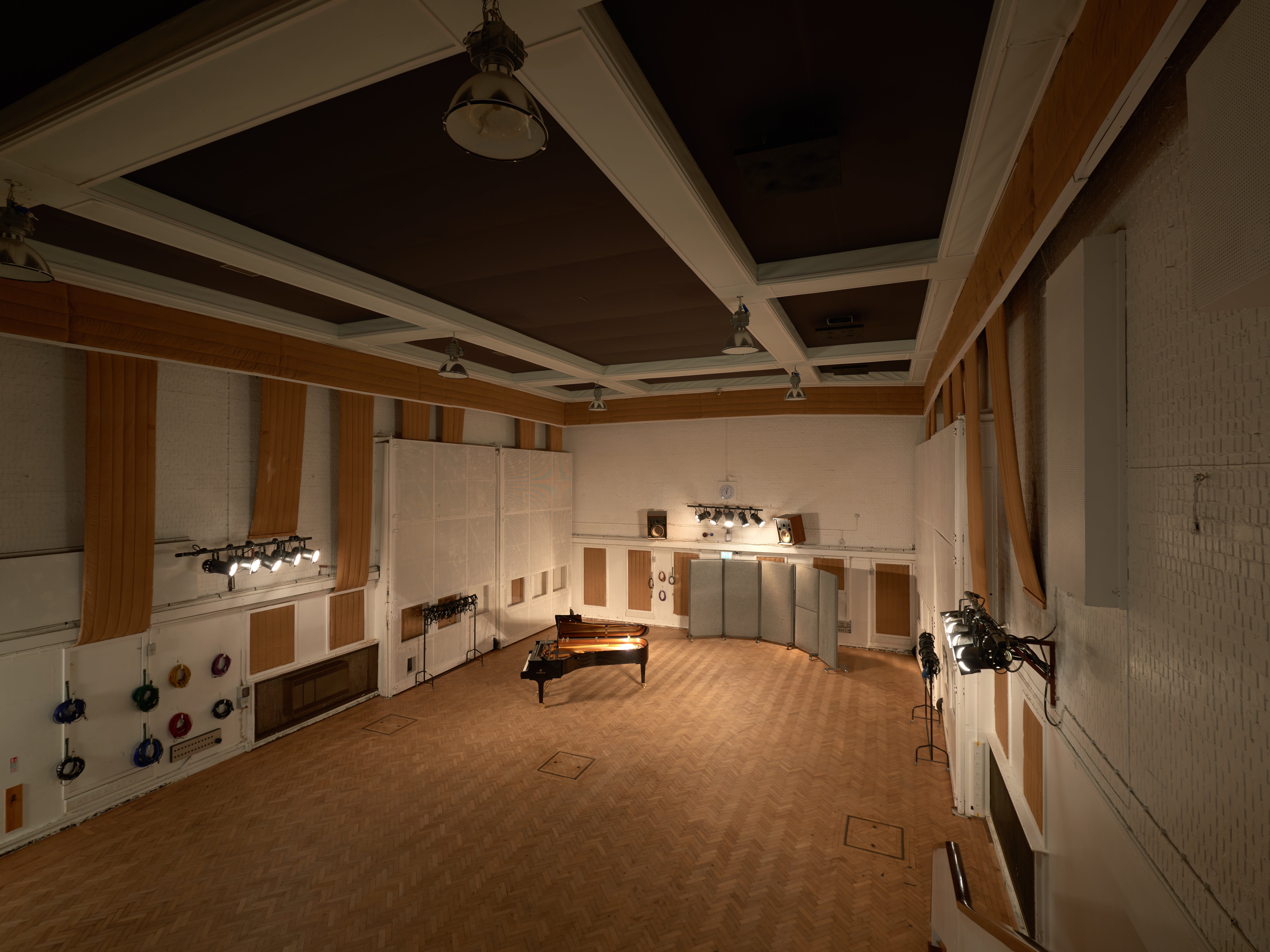
“We recognise that not everybody will be able to experience listening to music through Bowers & Wilkins speakers here at Abbey Road,” said Huffelmann. “So, for us, rather than keeping it as the preserve of people who can come to Number Three Abbey Road, we are very mindful of sharing the expertise, knowledge and creativity of our engineers over the years and using that to enrich everybody’s listening lives.
“Whether you're an artist coming to the studios to make your music or whether you’re an artist who records digitally anywhere in the world, now, for the first time, even if you're not a music maker, you can enjoy the experience of Abbey Road’s sonic DNA to shape the sound of your drive.”
Before I delved deeper into Abbey Road Mode in the Polestar, I wanted to find out a little more about the Bowers & Wilkins system in the car. And here I must reveal a little bit about my background.
Many years ago, I had a short sojourn into the audio world when I edited a title called What Hi-Fi Sound and Vision. Of all the audio companies I encountered back then, the one that impressed me most was Bowers & Wilkins. Put simply, it came closest to the car industry in terms of research and development, design, brand and marketing – and quality of the product.
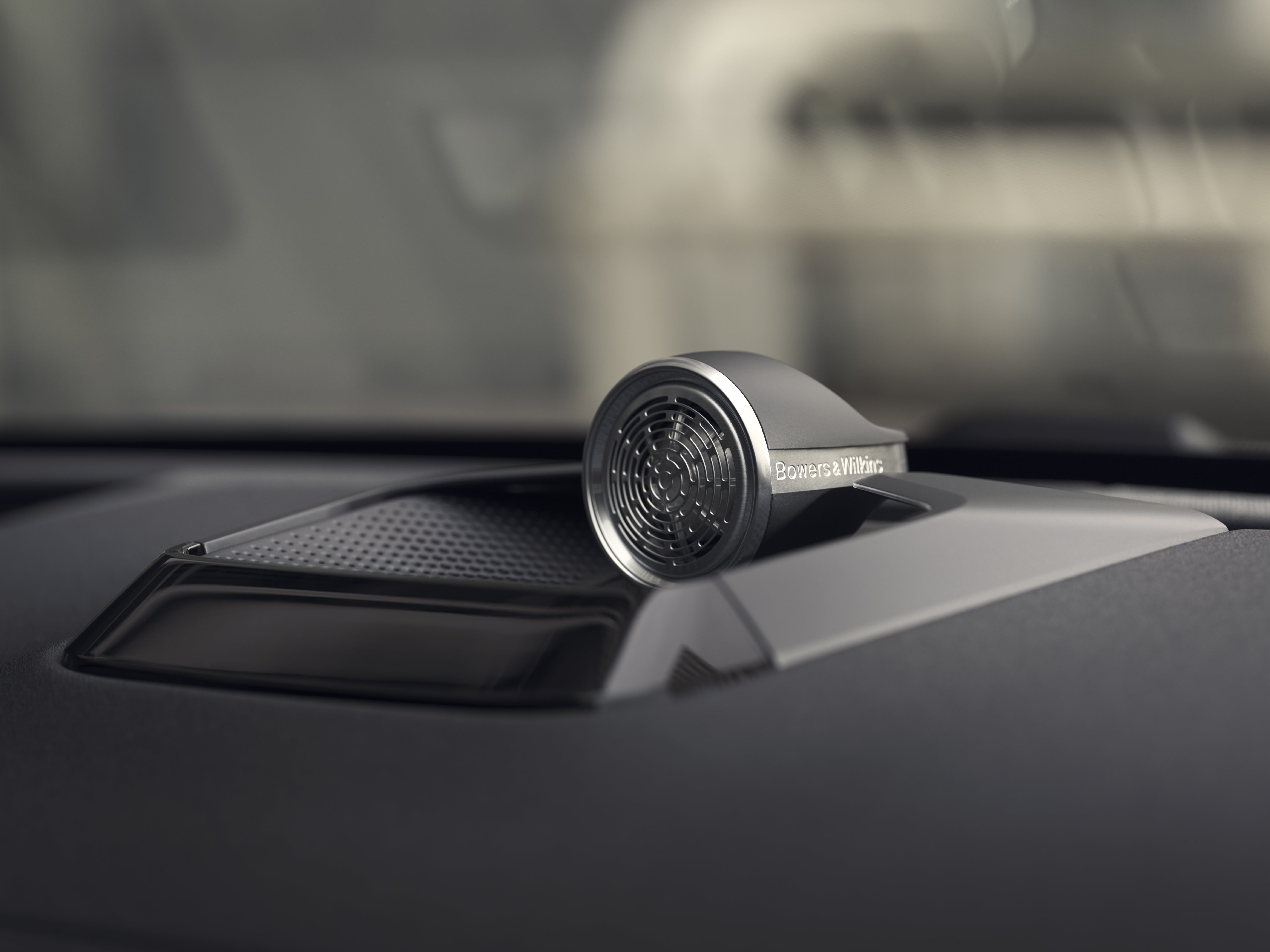
It helps that every single Bowers & Wilkins product I listened to then – and since – has sounded superb, including the brand’s first audio system in a Jaguar XJ. Now the company not only boasts Polestar and Volvo among its roster of automotive clients, but also McLaren, Aston Martin and BMW – not bad company to keep.
Bowers & Wilkins is based in Worthing on the south coast of England, where I met up with my former What Hi-Fi colleague Andy Kerr, now director of product marketing and communications at Bowers & Wilkins.
Andy revealed a bit about Bowers & Wilkins’ own storied history. The company was started by John Bowers and Roy Wilkins in post-war Britain in Worthing. Back then it was selling radios and parts – in effect an old-fashioned hi-fi retailer.
“John being John, he was looking into the products that he was selling and questioning whether he could do it better,” said Kerr. “By the mid-1960s his loudspeaker manufacturing business had turned into a sideline. You either went through the front door of the shop and bought the standard pair of loudspeakers from Mr Wilkins, or you went down an alleyway at the side of the store to a lockup at the back and bought a pair of modified loudspeakers from Mr Bowers.”
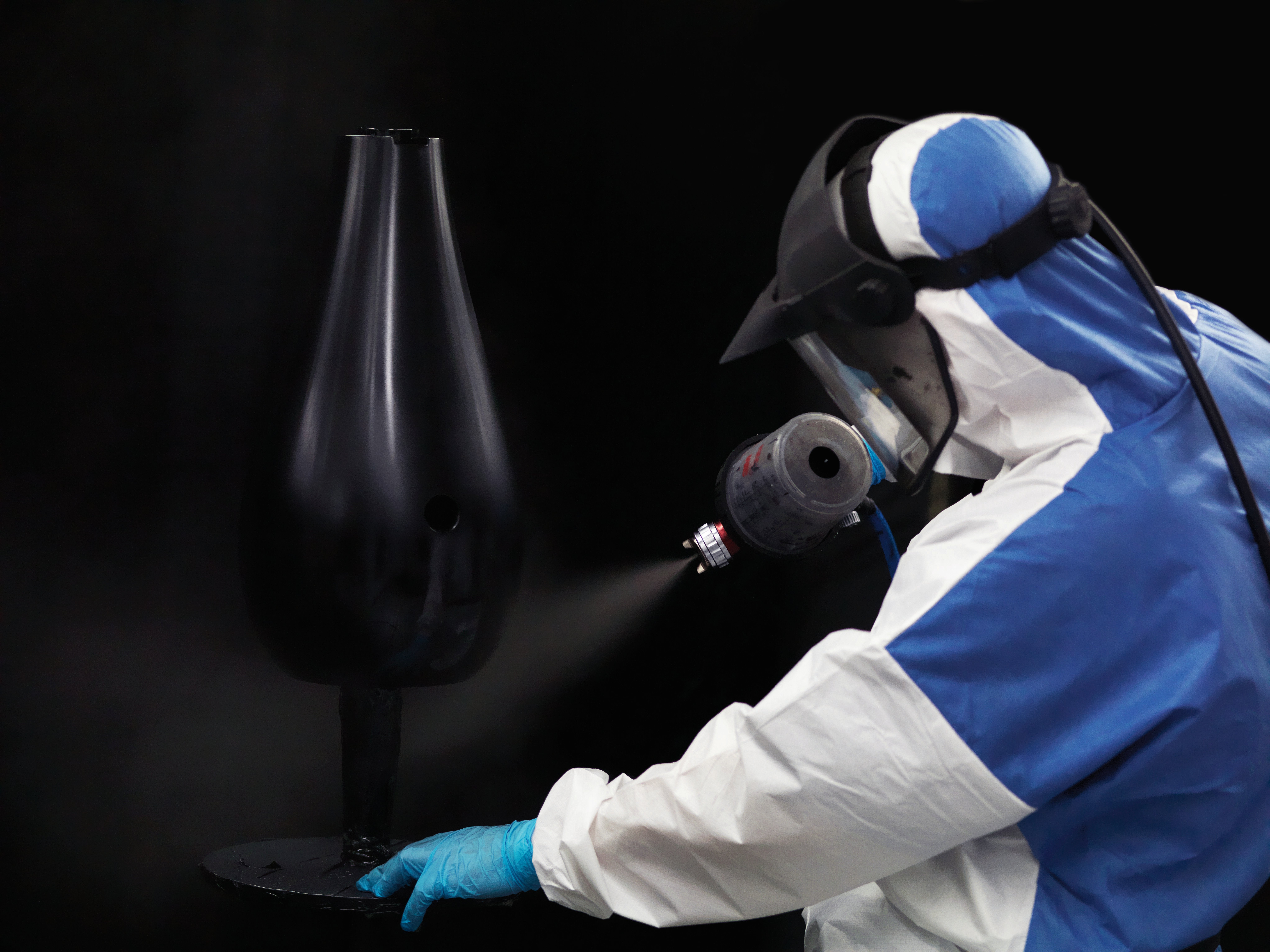
The business grew and grew, focusing on sound quality and design. Kerr explained the company ethos: “The best loudspeaker isn't the one that gives the most, it's the one that loses the least. And again, this directly links to that story around Abbey Road Mode and the premise of what we do to this day. The idea is that we're trying not to lose any of the original signal but rather deliver it as accurately and render it as realistically as we possibly can.”
Today Bowers & Wilkins employs over 100 people in research and development, and another 170 people in the factory that Kerr takes us around, looking at the very latest 800 series of speakers and the legendary, huge Nautilus models, which have to be seen to be believed.
The company’s range has expanded into the lucrative headphone market, too, with its premium headphones among the best you can buy, even though they’re made for, not by, Bowers & Wilkins. The same audio and quality standards apply whether they’re headphones or Worthing-produced speakers.
You can find care and attention paid to every aspect of Bowers & Wilkins speakers, from the bespoke Continuum cones used in the high-end speakers, to the tweeter-on-top technology that you’ll spot in some of the in-car audio systems. Of these details, my personal favourite are the Diamond Dome tweeters that use actual diamonds – specially grown in conjunction with diamond specialists De Beers Group – to provide the precise sound that Bowers & Wilkins engineers are looking for.
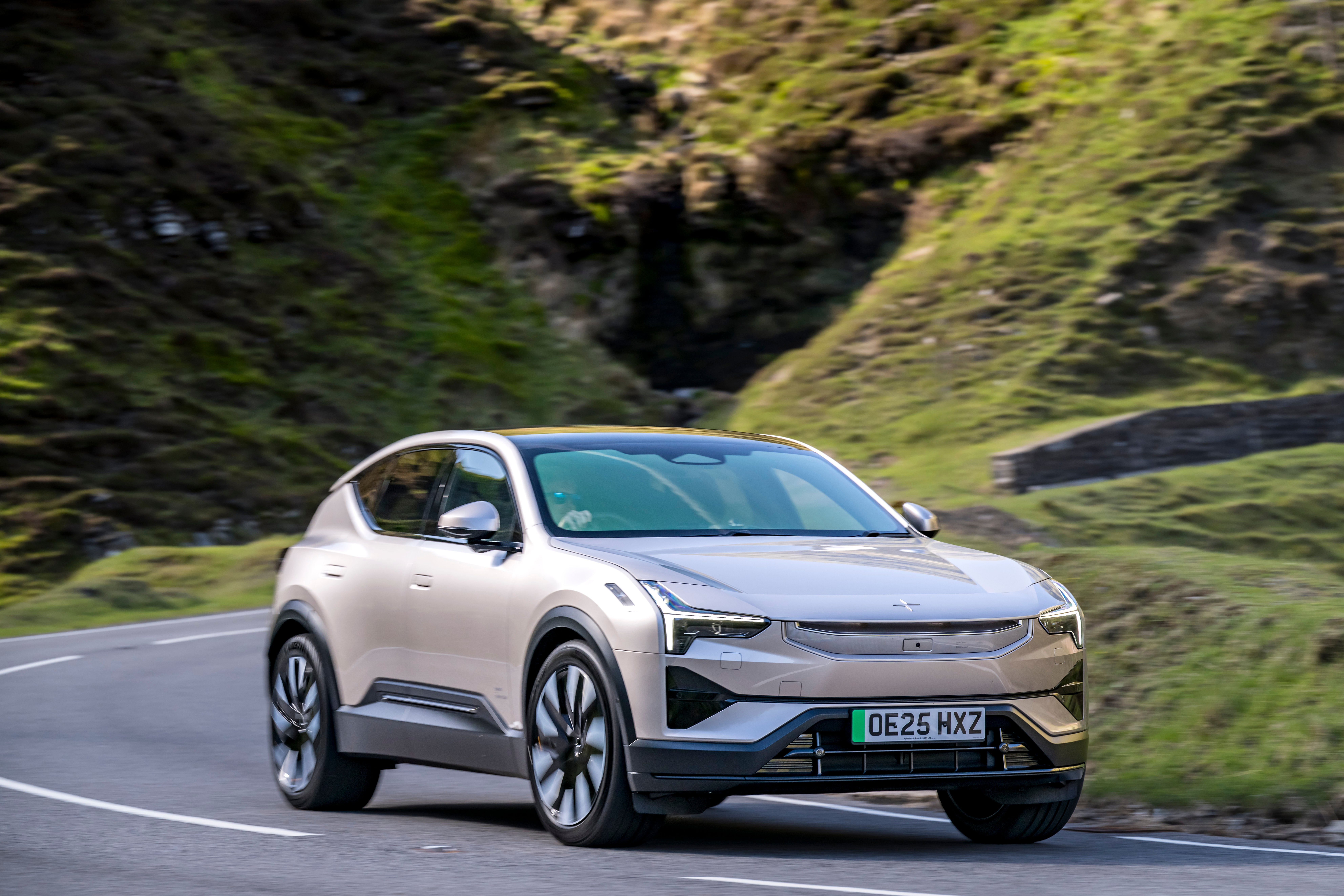
Leaving the factory, we get into the Polestar 3 with George Fryer, Bowers & Wilkins’ lead development engineer for automotive. Fryer talks us through the 25-speaker set-up in the Polestar. “We have a 25mm double dome tweeter, effectively taken from our 600 series loudspeakers. We have a Continuum mid-range in the dashboard, and we have a 170mm woofer in the lower door. We have a duplication of that in the rear doors, so we have what’s called three ways in all the doors. And we have a two-way in the centre with our beloved tweeter-on-top that’s front and centre.
“We have a 10in subwoofer in the boot, what's called a fresh air sub, so effectively using the car cabin as a loudspeaker enclosure, which means we get really deep bass, one of the leading attributes in this car particularly. Then we have four 3D speakers, these are 40mm full range speakers above us. That allows us to create a more immersive listening experience and, of course, Dolby Atmos. And we have headrest speakers in both front seats and surround speakers in the back.”
The app mirrors the studio’s famous dark wood and lets you change the sound depending on the vintage of equipment you might be using
A similar system is available in the Volvo EX90, but what’s the difference between that and the Polestar 3? “In the Volvo we may have a broader sound stage, a wider sound stage, because it’s a bigger car. And in this Polestar 3 we typically have a taller and higher sound stage. So it’s really a question of width or height. They both have their merits, but ultimately that’s a conversation we have with the various design teams that lead us to where we are,” explained Fryer.
The Dolby Atmos sound is spectacular, and I marginally prefer it in the Polestar. It’s well worth a demo. But what I’m really intrigued to know more about is the Abbey Road Mode, which – according to Fryer – has been four years in the making.
You must be stationary to use the Abbey Road app on the touchscreen, but the look of the display is a work of art. It mirrors the famous dark wood found all through the studios and lets you change the sound depending on the vintage of equipment you might be using, or whether you’re listening in the studio or control room. Fryer takes us through it.
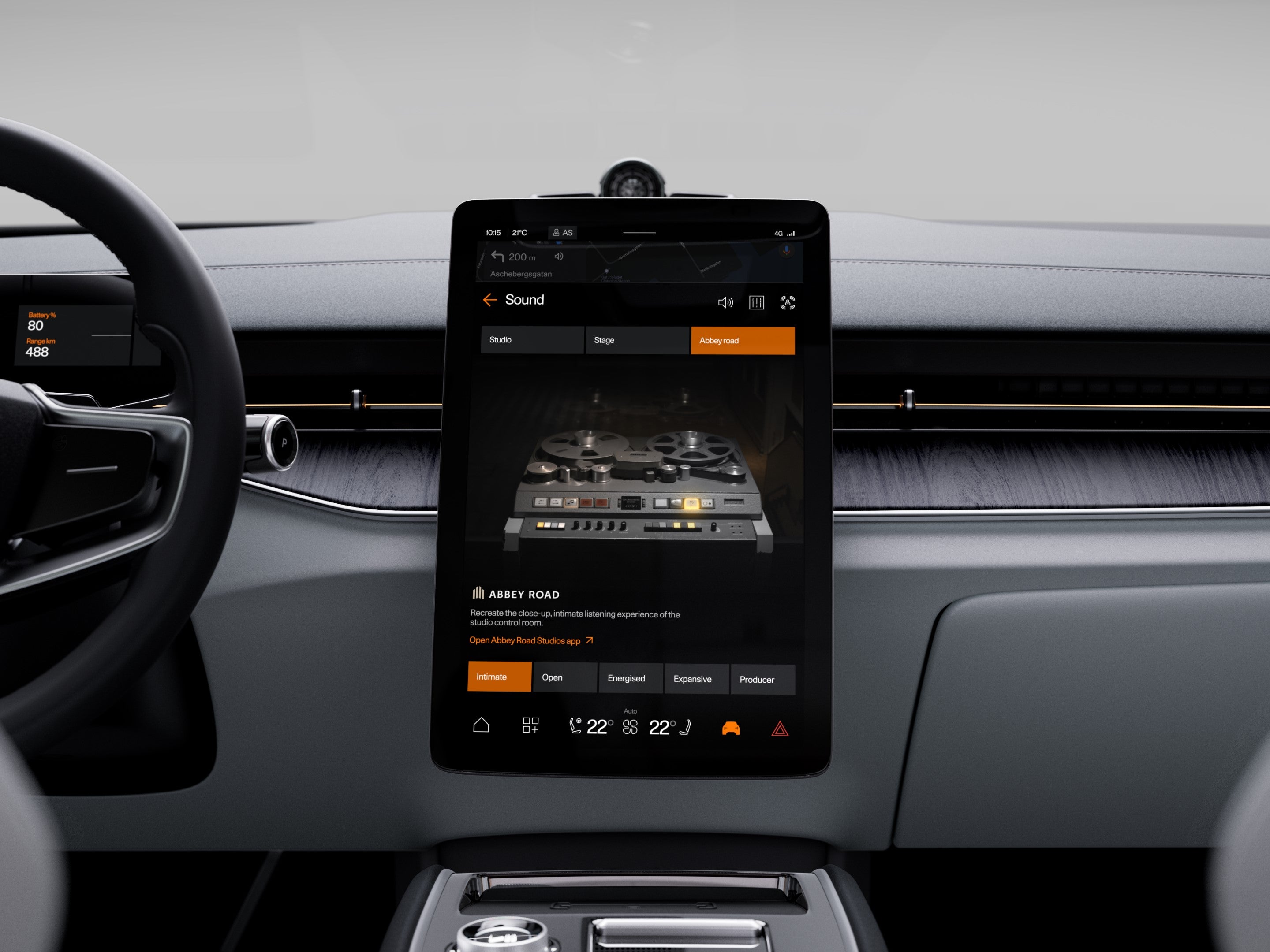
“Abbey Road have developed a lot of bespoke hardware, so compression and expansion equipment, spreading equipment and the like. And of course, there are the people, so this mode has been developed with Team Abbey Road throughout.
“What we’ve done is create this producer mode window. What we’re doing here is we’re giving users control of three different kinds of parameter sets. We have a spatial control, which is visualised here – this allows us to move from the closer, more intimate setting of a control room through to the more open ambience of a live room. That’s all captured from three days’ worth of measurements we took from Abbey Road Studios.
“As we move around the screen in this kind of rotational direction, we are introducing a vintage or a modern tone, and that's all built upon digital remodelling of bespoke hardware, developed at Abbey Road.
With this you're looking at a known entity: I know where the speakers are, I know where people are going to be sat.
“And then the third control is the spreader; this is using, again, digital remodelling of bespoke hardware. This gives us control of the sound stage width, so narrow all the way through to wide. One thing I'm a particular fan of is, as you can see as we move around this space, you can see the Bowers & Wilkins speakers change as we move through the generations.”
According to Fryer, the perfect starting point for a system like this must be an EV. “The lower noise floor is a big deal. That, combined with air suspension and double glazing, really cuts out of a lot of noise which makes our life easier,” he said.
And a good track to test the Polestar 3’s Dolby Atmos system? Fryer does a quick search and cranks up Bad Guy by Billie Eilish, a track that’s been specifically mixed for Dolby Atmos and sounds truly spectacular.
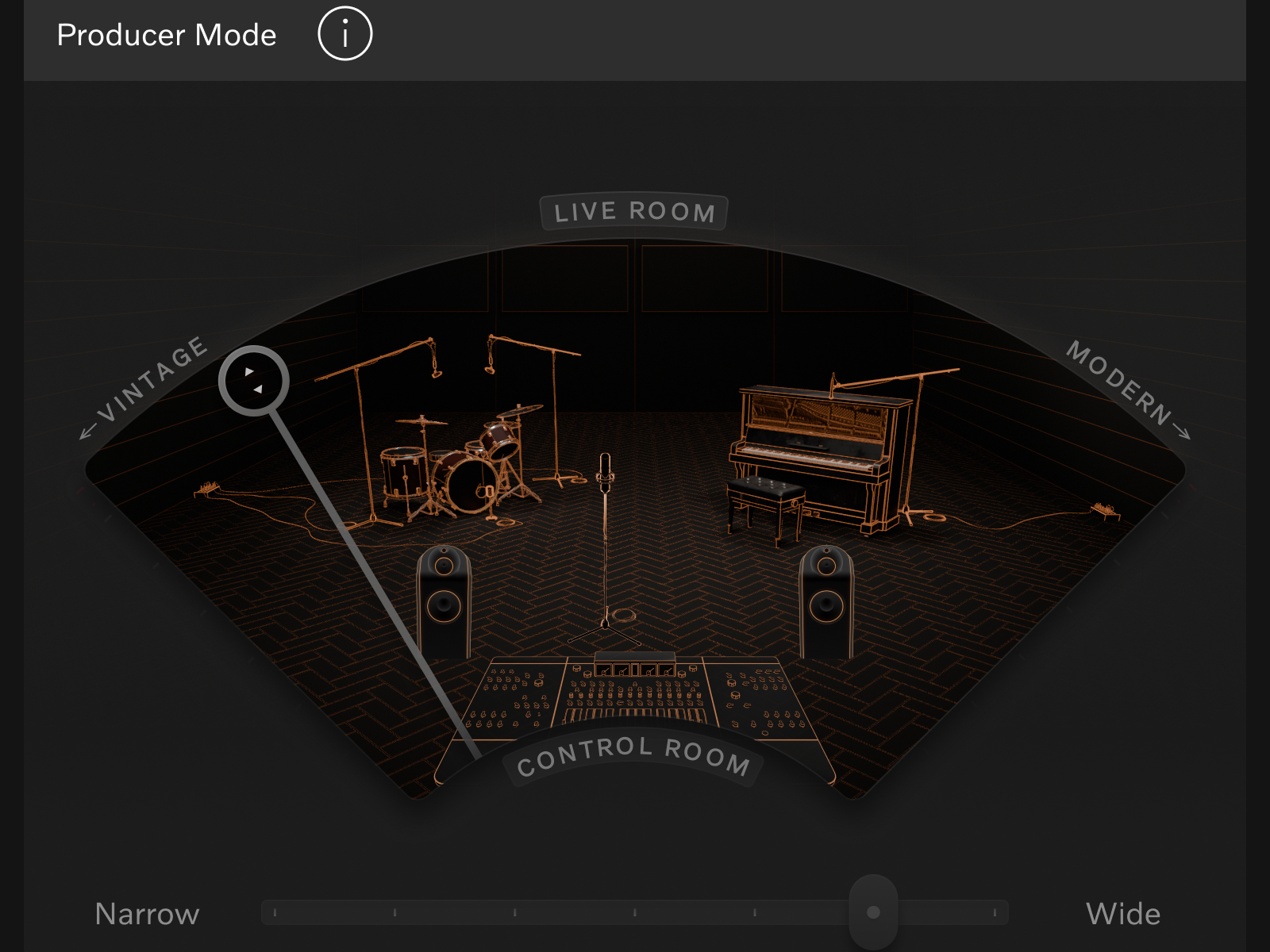
Back at Abbey Road we catch up with Jeremy Huffelmann and another long-time Abbey Road employee Mirek Stiles who, in his 26 years there, has seen many of the world’s most iconic artists at their most creative – and played a big role in what they’ve produced.
From starting as a runner to now being head of audio products – and the man behind the sound of the new Abbey Road Mode – Stiles explains what the Abbey Road sound is.
“If you add all the different flavours together, that creates the Abbey Road sound.
“What I mean by that is the acoustics of the rooms, which are completely unique – you can't get that anywhere else. A lot of the equipment you've seen around here, a lot of it was made for Abbey Road. And if it wasn't made for Abbey Road, it has history – we've got a microphone collection going back to the 1930s.
“Then you add those two elements with the expertise of the people who work here in the engineering team, the vibe they give off and how they make artists feel. All that combined creates the Abbey Road sound – and it’s unique, completely unique.”
Huffelmann adds, “when we first sat down we asked: what is the DNA that we want to try and wrap into the car mode? It was those three key pillars of the experience that are unique to us.”
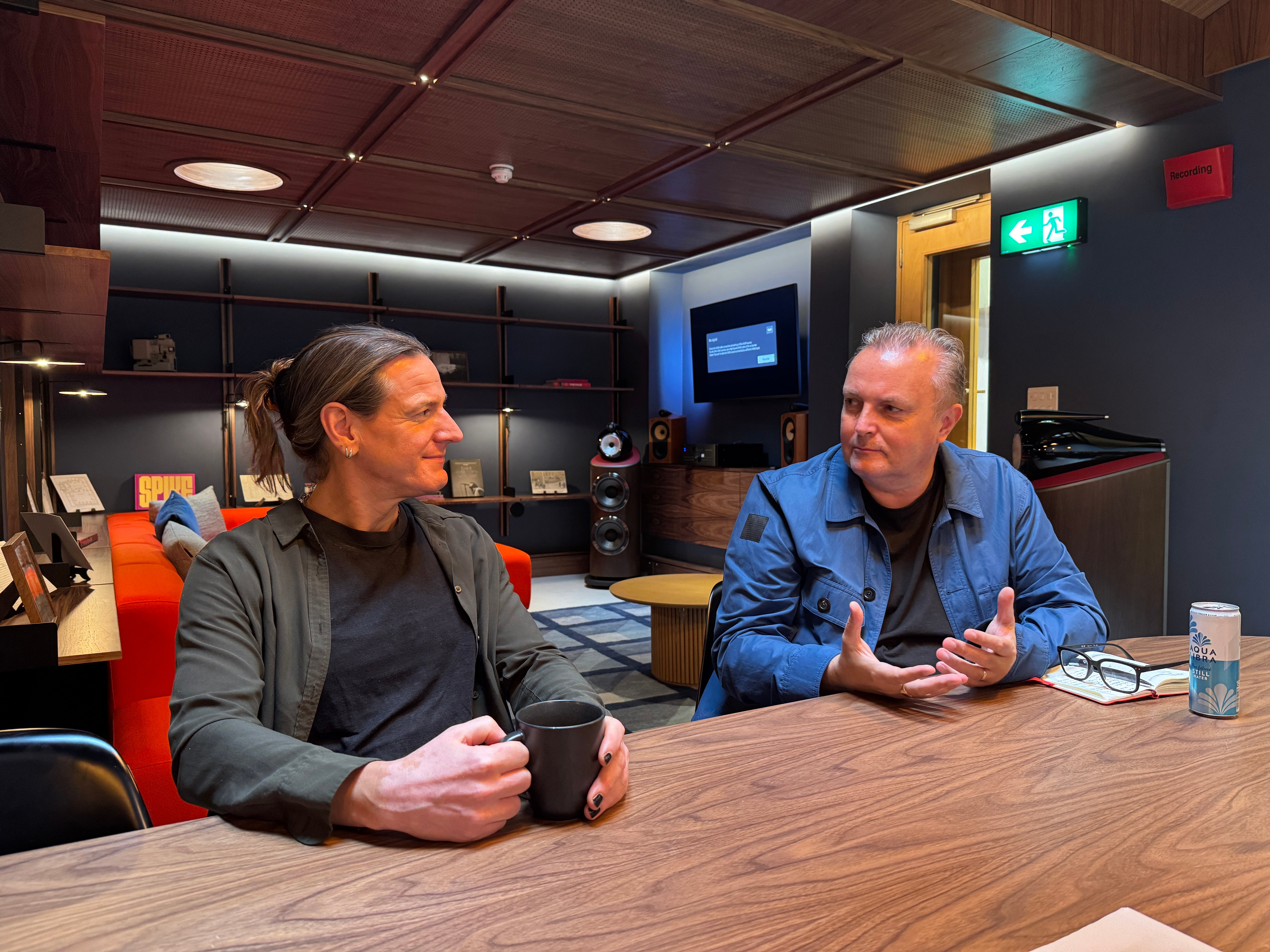
Working in the environment of a car’s cabin provided Stiles with new challenges but also provided some benefits. “The most interesting thing about working on this car project was that most of the music I’ve worked on over the years, once it leaves this building, I have no idea and no control about how it’s going to be listened to, where it’s going to be listened to and what systems it’ll be listened to on.
“With this you're looking at a known entity: I know where the speakers are, I know where people are going to be sat.”
The Abbey Road team had absolute sign-off on the Abbey Road Mode in the car – as well as the look of the app. From the start of conversations in 2020, it involved many hours sitting in pre-production cars in Gothenburg with the cars’ cabins becoming Stiles’ new studio. And it’s technology that’s now making it all possible.
“It probably it wasn't possible before,” said Stiles. “We weren’t in a position to integrate our technology into an automotive platform.”
“Part of what’s been great about our relationship with Bowers & Wilkins is we’ve always, in the simplest way, tried to do really cool things together, we are all massive audiophiles.
“We love music and we love sound. We’ve had some amazing moments in the studios. For example, we sat inside the orchestra while they played the Bond theme as part of the launch of the celebration of 60 years of Bond. So, we've always set ourselves these goals of doing incredible things.”
The reaction from some of the artists that have been working at Abbey Road has been incredible so far.
“It’s been absolutely phenomenal,” said Stiles. “Composers and artists, everyone from people who work in rock or rap, hip hop and more, they’ve sat in the car. I don’t know what they’re expecting, but they’re sitting in the car and the moment we start playing music they’re familiar with we turn Abbey Road Mode off, so you can get your bearings before and after. Once you take it away, they’re like, ‘I want it back on again’.
“They're blown away, they’re hearing things that they weren’t necessarily hearing on the track they’d just been listening to in their studio at home or wherever. I think the reaction has been incredible in terms of what can be achieved sonically.”
.jpeg)
It’s time for me to be the judge of that, so we head out to the Abbey Road car park, right in front of that famous entrance, with intrigued tourists looking on, to try out Abbey Road Mode.
But what should we be listening to? “My assistant Sarah and I sat in the car last week and we were listening to a track we both love from a band we’re both really influenced by,” said Stiles. “It’s Tears for Fears – a song called The Working Hour. It just sounded epic. It blew us both away.
“That saxophone solo, well, the saxophone intro and then the saxophone solo in the middle. Sarah said to me that she knew that song inside out, but she heard a new guitar part at the end. She’d never heard that guitar part before. It just blew us away, so that’s what I’d choose, personally.”
With my love of eighties music, this was a track I knew well, too. And yes, it did sound epic. And as Stiles suggested – dropping in and out of Abbey Road Mode via a simple button in the interface, really shows the quality of the work he and the team have done.
There’s a warmth and detail to the sound that probably only the Bowers & Wilkins system could highlight. And the interface is as fun as it is clever, watching the instruments, the control deck and the Bowers & Wilkins speakers change as you move across generations and back and forth from the studio to the control room.
I’d been impressed by the Polestar 3’s audio before, especially when playing properly mixed Dolby Atmos music in it. But Abbey Road Mode brings something very different, very authentic and hugely impressive.
If you love listening to music, try and persuade your local Polestar dealer (or Volvo dealer come to that) to let you have a listen to Abbey Road Mode. It’s almost like The Beatles are in the back of the car with you.
Best used electric cars 2025: Top 10 second-hand EVs
So much for cheap Chinese cars, the BYD Atto 2 is an expensive one
Fiat reckons it’s found the formula for the perfect road trip playlist
12 longest-range EVs I recommend buying as an EV editor
BYD Atto 2 review: This family-friendly EV can’t compete on price
Hyundai Ioniq 9 review: Seven-seat luxury for your family and their friends







